Toward the Future We Have Yet to Shape: A Review of Mjolnir 4: The Wedding March
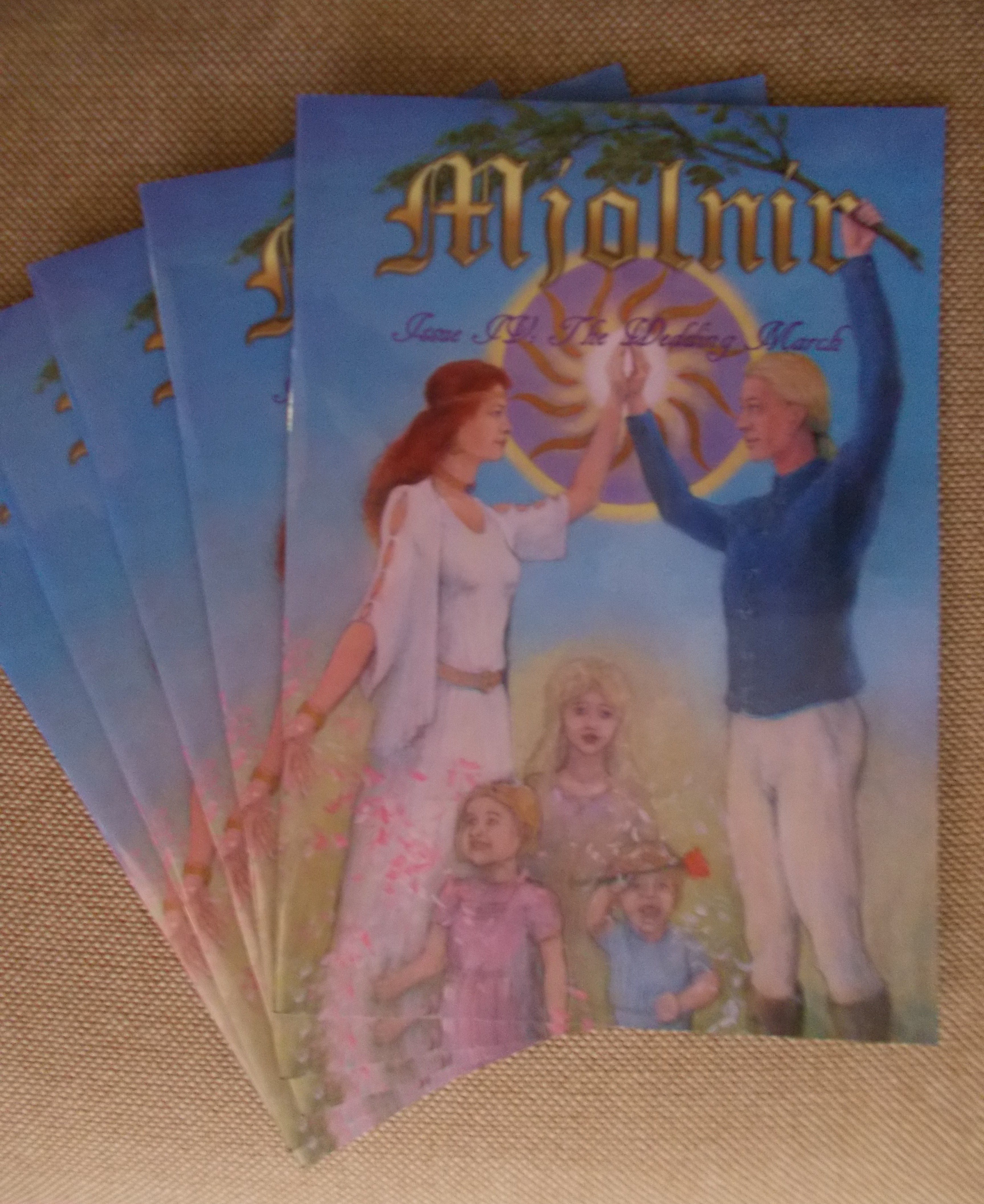
Mjolnir 4: The Wedding March
So many magazines become formulaic by Issue 3, let alone Issue 4. Mjolnir Issue 4 –subtitled “The Wedding March”—is not one of them. Mjolnir never has been. It is always a delight to receive the latest copy, not knowing what interesting words and pictures wait inside those full color glossy covers.
Not to say that Mjolnir is chaotic or haphazard—far from it. Editor Dave Yorkshire does a splendid job of keeping to his original statement of intent: to publish true Eurocentric traditional art forms, and he has managed to do it for four issues so far, remaining elitist and illiberal in the best possible manner. (I see in his editorial that he is testing the waters of YouTube via the Alt-Right channel Millennial Woes, and also checking out the feasibility of holding regular Eurocentric Cultural Festivals—both of which I am sure Mjolnir will successfully navigate in due time).
The essence of “The Wedding March” is summed up nicely in the final sentence of the editorial: “If European Man is to survive, he must embrace a future that is vernal rather than autumnal, that promotes life, birth and rebirth, and marriage as the sacred pact that binds this continuum that stretches from the prehistoric past into the future we have yet to shape.”
We’ll skip over my contributions to this issue, only noting that I contributed poetry as well as a short story, and turn first to the literary contributions of others. And there are many to savor, from all areas of the European literary triad: fiction, drama and poetics. Contemporary poets Ellin Anderson, Eliza Witte and Dorin Alexandru; nineteenth-century narrative poet Thomas Ingoldsby (pen name of Richard Banharm, in case you wanted to know), fiction writer Ann Sterzinger, and Dave Yorkshire himself with another ultimate gem in the form of a parody/drama.
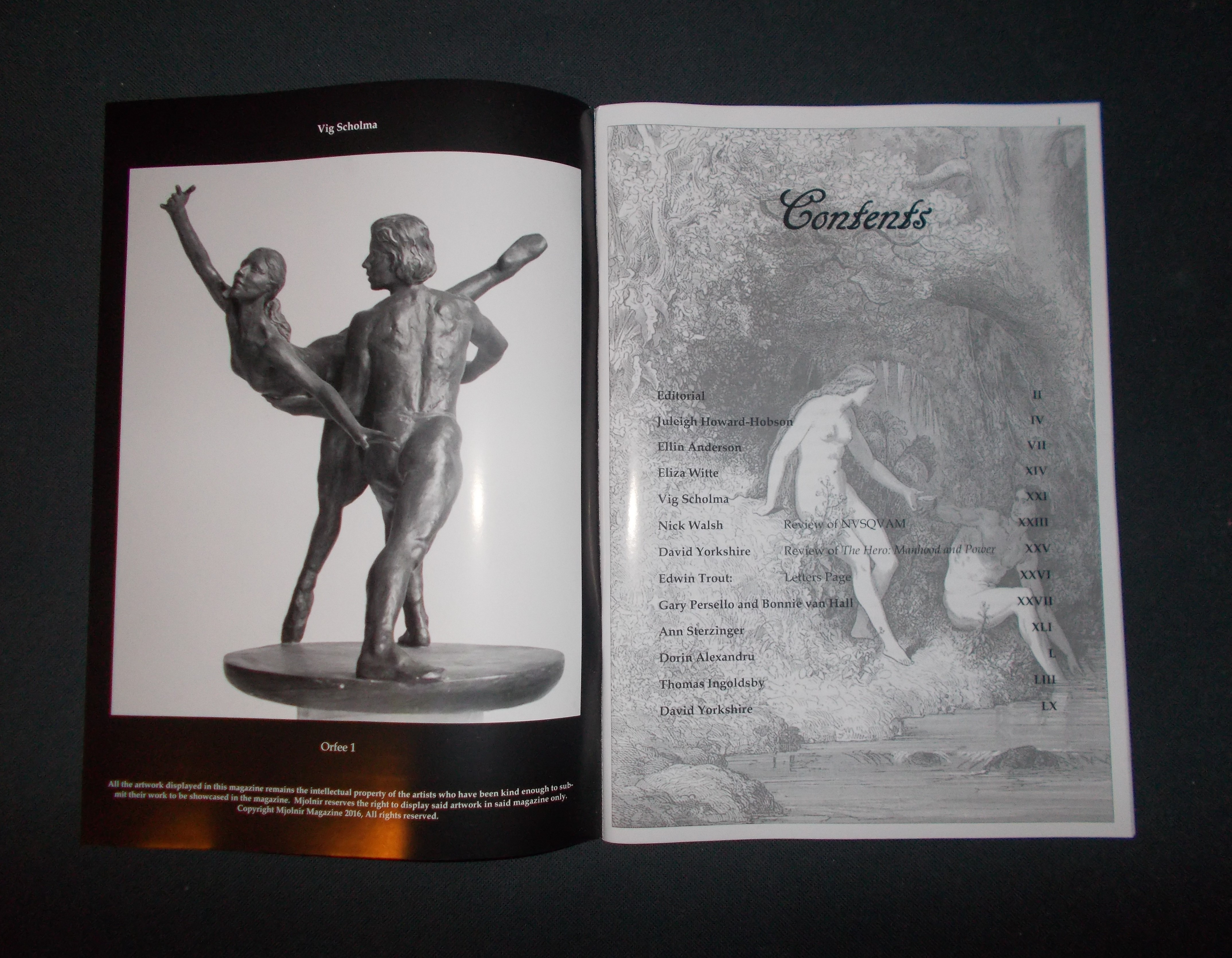
Contents and sculpture by Vig Scholma
The poets here, while their works are in English, are representative of a pan-European cultural milieu.
New Englander Ellin Anderson, with her sonnets and ballads, exerts a strong American—indeed a Longfellow-ian—influence combined with traditional European themes: The formal quatrain “A Bride’s House” is typical of her fluidly straightforward poetic style:
That far off June when Butterflies
Met flowers in a field—
A simple sum in Nature’s guise,
A precious truth revealed,
Is held and cherished like a toy
Until, among the stones,
The birds who seemed to share your joy
Sing to a box of bones.
The simple poetry of the ABAB rhyme is made beautifully complicated by that final image. The artistry displayed is easy to appreciate, difficult to do well. All seven pages of her poetry are superb—space alone allows me to quote from only one. Note, also, that richly artistic black and white photographs accompany these poems — her works as well.
Eliza Witte, Austro-Bulgarian poet and playwright, brings to Mjolnir a meandering ribbon of emotive Neo-Victorian formal pieces and more organic ones along with a mix of near rhymes and acrostics. Of them, “Summer Son” is my favorite, opening as it does with such a well-written uncompromisingly European image:
Swimming in those blue depths of your eyes, I got drowned in my/
Unreason/ …
Witte’s poems are accompanied by black and white reproductions of the art of Bouguereau (French, 1825–1905) which serve to underline the European cultural feel of each piece.
Now I will say ‘last but not least’ and actually mean it — a Transylvanian poet,
Dorin Alexandru, is the last of the poets included and far from the least talented—his poems are modern, with a lush sensibility to them that belies need for strict traditional form, while keeping to European aesthetic standards. His is a poetry of repeated words, of soft syllables, of stillness and modern life. “The Hill Where I Lay Myself to Rest” closes with words that reflect the haunting beauty of all his work: “I choose this place of rest, so restless. / Where hill meets skull and heaven meets fire / and stick with stick in turn collides here.” Three early works of Futurist artist, Giacoma Balla (1871–1958), illustrate and support these poems perfectly. As editor, Yorkshire does a nice job of balancing and matching poem to painting throughout the magazine.
Speaking of which, Ann Sterzinger’s short story “What Women Want” is threaded throughout —quite effectively — with 11 reproductions of American artist Edward Hopper’s stark paintings (two are in color). The story is a good fit here, in an issue where marriage and love are the focal theme, revolving around the idea that no matter how bleak modern life is, if you do find that special person, life is no longer just a part of the mundane world, there is something more: “they swayed out into the traffic on LaSalle like they were walking into a wheat field.” Caveat: given the anti-natal stance of Sterzinger and her overall misanthropic and hopeless views on life, the inclusion of the wheat field is a jibe on finding the perfect woman. (There is even a Facebook group dedicated to this sort of thing: https://www.facebook.com/AryanWomenInWheatFields/) which I thought a bit jarring, and a teensy bit forced (*) but I am pro-natal and ever hopeful, so it’s to be expected I guess.)
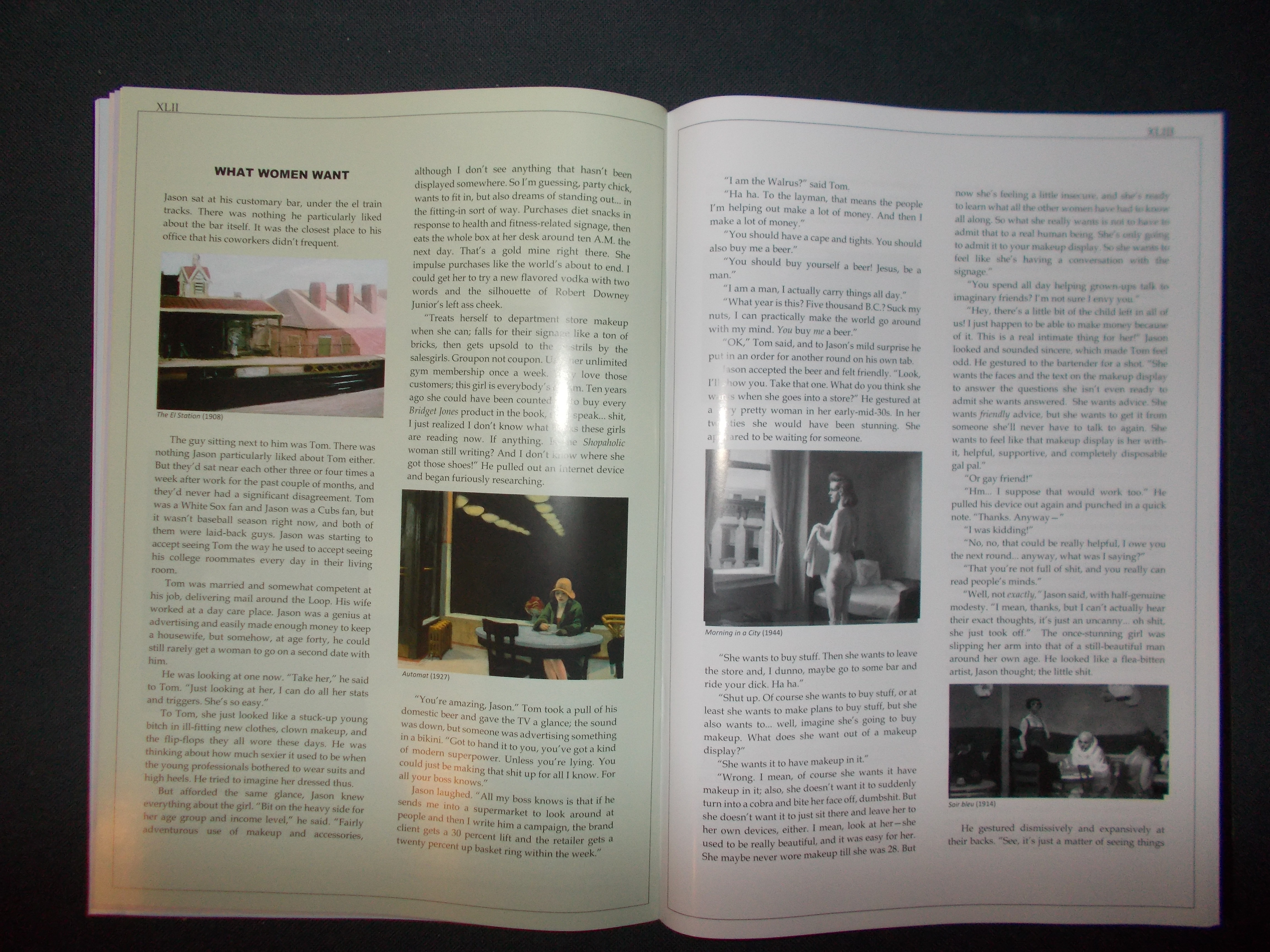
Art that speaks from the soul of one European to the souls of all others is rare these days—the art world of the establishment is not the art of our world. Still, there are artists who do dare to create aesthetics that harmonize with our cultural spirit. Vig Scholma is one of these. His painting graces the front cover of Mjolnir (again!), and black and white photographs of his bronze sculptures grace the pages within as well as the inside front and back covers. His sculptures of ballerinas (‘Attitude”, “Arabesque”, “Volante”) the female form (“Iris”, “Kwetsbaar” and “Priya”) and of a pair of dancers ( “Orfee” and “Orfee 2”) are as beautiful as they are graceful as they are dignified. If you weren’t informed that Scholma created them in his lifetime, you would assume they were treasures of the grand European past. Instead these are treasures of our future. I wish there were more of them included here, but that is me being greedy.
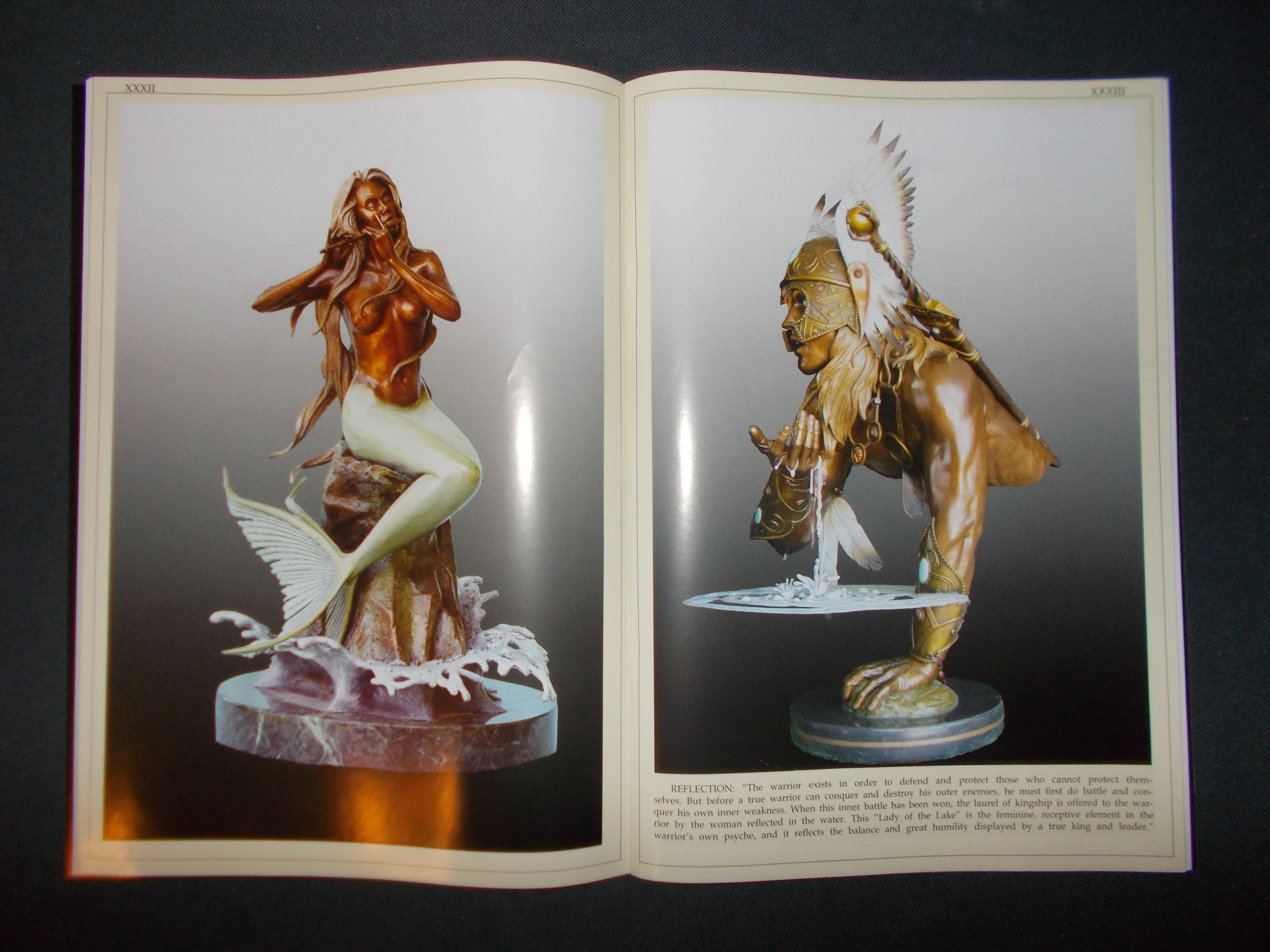
Sculpture by Gary Persello
The fantastical sculptures of Gary Persello are as interesting as they are unusual—created by an artist who remains true to his aesthetics of excellence rather than to the pressure of easy modern mass production. And it shows. There is a unique sensibility to each of the seven sculptures photographed in full color for Mjolnir — from the effervescent “Genesis of the Djinn (God) Within” which spirals upward (motion is evident even in two dimensions), to the realistic surrealism of the fairy-blown dandelion seeds in “Pixie and the Puff” — these are works created by a master of his art, and of his culture.
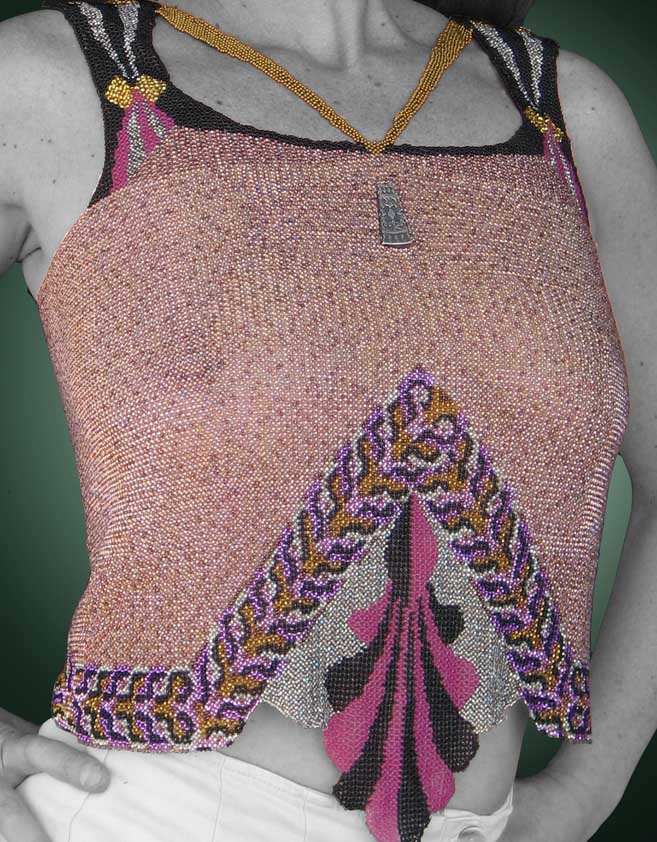
Beadwork by Bonnie Van Hall
Bonnie van Hall is married to Persello (an apt team for this Wedding March issue). Her beadwork is surprising to come upon in Mjolnir—it is neither literary nor purely artistic. It is beading made into clothing, jewelry and personal accessories. But, read her own words, which preface the color photographs and it all becomes clear:
My art is a vehicle for my personal expression of beauty, and love and gratitude to my ancestors…. Ultimately I view creativity and the act of creation as an antidote to the death culture that has permeated the world around us.
Her work is certainly alive—and rich and jewel-like—and there is a palpable soul to it, each and every brilliant shining bead is meticulously chosen and placed. Mass production can never reproduce the artisanal craftswoman. Handmade European and European-Diaspora pieces must be seen, must be celebrated; Mjolnir has been consistently at the forefront of showing the world what our folk are still capable of. This is part of what makes each issue such a joy to receive.
Mjolnir has also been consistently at the backfront (is that a word?), highlighting pieces that have long been neglected, but rightly deserve to be noticed again. This issue brings us a story from the popular Victorian “Ingoldsby Legends,” by Richard Barham. Dave Yorkshire points out that it is a retelling of “The Merchant of Venice,” “remarkable for its portrayal of Shylock the Jew. Shylock is an explicitly racially other. He speaks with an Ashkenazi accent, reflecting the concerns of Barham’s era, as Jews rose to power in Britain first in finance and then in politics, following an influx of Ashkenazim that included the infamous Rothschild family”:
That Shylock came with him, no longer a Jew,
But converted, I think may be possibly true, / … /
By changing the y in his name into er”…
There is a decidedly jaunty bounce to this whole poem that keeps one reading it happily, despite the fact that is presented in six double-columned pages — interspersed, it is true, with four George Cruickshank sketches (some of which appeared originally in The Ingoldsby Legends).
Following on the heels of this rather humorous “legend,” comes a straight-up parody piece—and a dramatic piece at that. “The Marriage of William Shakespeare” is penned by Dave Yorkshire himself, so to those who think they cannot stand to read plays, even parody plays, I say that they will enjoy this one. It’s breezy and easy. Not that I am saying it is pointless or vapid. It carries a clear message about modern life and modern love — like a sharp hook sunk in a big jolly worm—within its breezy easy lines.
SHAKESPEARE: Wait! If you’re a real woman, I’m not marrying you!
ANNE: What? But I thought you loved me. You told me that the shape of my genitals didn’t matter one bit to you.
SHAKESPEARE: Yes but that was when you were gender queer.
Add to the aforementioned: a page of farcical letters, a nicely penned review I mention as a footnote here (*), ads for right-thinking people, and the fact that Yorkshire has managed to get not only color photographs but colored pages themselves into the magazine, and you have a truly remarkable issue. One that I enjoyed immensely, start to finish.
* Of course, one might just as easily call it a “pithy cultural observation,” to borrow a phrase used by reviewer Nick Walsh in his excellent review of Stersinger’s NVSQVAM (Nowhere) on page 23 of this same issue.





Comments are closed.